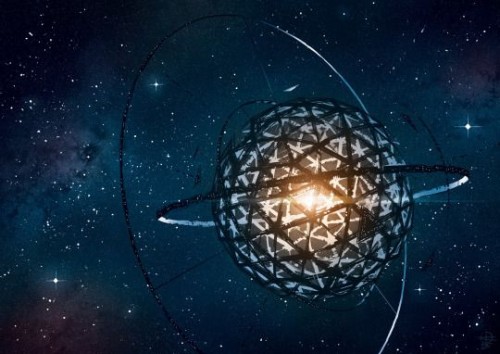A bold solution: the Dyson Sphere. Matt Caplan, an astrophysicist at Illinois State University, Proposes Turning the Sun Into a Gigantic Engine. This megastructure—usually conceived of as a gigantic shell enclosing the sun, lined with mirrors or solar panels—is designed to collect every iota of a star's energetic output. In the case of our sun, that colossal figure is 400 septillion watts per second, which is on the order of a trillion times our current worldwide energy usage. What's more, the interior of the Dyson Sphere could, in theory, provide far more habitable real estate than a measly planet.
Physicist Freeman Dyson was first to speculate that a technologically advanced race, reaching the limit of its civilization's expansion because of dwindling matter and energy supplies, would seek to exploit their sun for all it is worth.
"One should expect that, within a few thousand years of its entering the stage of industrial development, any intelligent species should be found occupying an artificial biosphere which completely surrounds its parent star," Dyson wrote in the 1960 Science paper that led to his becoming the namesake of this megastructure.
A Dubious Sphere
From an engineering perspective, a Dyson Sphere sounds pretty wild. And it is: As an immense, hollow ball, the structure is impossible. "An actual sphere around the sun is completely impractical," says "Stuart Armstrong, a research fellow at Oxford University's Future of Humanity Institute who has studied megastructure concepts.
Armstrong says the tensile strength needed to prevent the Sphere from tearing itself apart vastly exceeds that of any known material. Another problem: The Sphere would not gravitationally bind to its star in a stable fashion. This is perhaps counterintuitive; you might think that a perfect sphere around a star would be stable. But if any part of the sphere were nudged closer to the star—say, by a meteor strike—then that part would be pulled preferentially toward the star, creating instability.
That's too bad. If it could be stabilized, a Dyson Sphere built at 93 million miles from the sun, the same distance as the Earth, would contain about 600 million times the surface area of our planet in its interior. However, comparatively little of the surface would be habitable on account of a lack of gravity. By spinning the whole sphere, you create gravity in the form of centrifugal force along an equatorial band. But this rotation would wrack the megastructure with yet more destructive stress.
While a Dyson sphere is necessary for the reactor concept, the solar sail design relies solely on an enormous parabolic mirror that converts starlight into motion. As photons from the star bounce off the mirror, momentum is generated, allowing the star system to move about 100 light years over 230 million years.
The solar sail has the advantage of simplicity—for a megastructure concept, that is—but it would probably be too slow to dodge a supernova. Also, in our own solar system, the sail would need to cap one of the Sun’s poles to prevent sunlight from becoming amplified into a death ray that incinerates Earth and other worlds, or getting blotted out entirely. As a result, this engine could only push the solar system in the direction of the Sun’s poles.
Caplan’s second proposed stellar engine, a thermonuclear driven jet, overcomes some of these pitfalls. The core of the design is a fusion reactor fueled by energy harvested from the host star. Some of this energy could be collected from the solar wind, a stream of charged particles emitted by stars. But to really hit the gas, the engine would need a Dyson sphere to redirect starlight back to a star’s surface, which would cause temperature spikes and huge ejections of helium and hydrogen.
As cool as these concepts are, they are far beyond the current technological capabilities of humans, and scientists have never detected signs of this kind of advanced engineering elsewhere in the universe.
"The thing that physics says should be possible is only an absolute upper limit," Caplan said. "There might be other engineering or practical limitations that prevent really good sci-fi technologies from actually being realized, not just by humans but by any advanced civilization."
That said, the hypothetical megastructures do provide a speculative roadmap of how humans could one day navigate the cosmos. They also allow scientists to make educated guesses about the type of detectable signals we might expect star-hacking aliens to produce, such as infrared radiation from harvested stars.
For now, scientists will keep looking for signs of stellar engines, and other megastructures, though it may be too early in the universe’s lifespan for such advanced technologies to have flourished.
"Maybe there are civilizations that have succeeded in building Dyson spheres and all this other fun sci-fi stuff, but they have yet to—even with exponential growth—fully take over galaxies," said Caplan.

Humankind is energy hungry. As our civilization has industrialized over the last couple centuries, global energy consumption has spiked more than twentyfold with no end in sight. When demand outstrips what we can reap from Earth and its vicinity, what will our power-craving descendants do?




